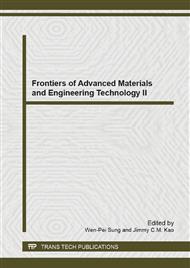[1]
Cha J, Kim TJ, Park B, The effect of a metal oxide coating on the cycling behavior at 55°C in orthorhombic LiMnO2 cathode materials, J Electrochem Soc, 2002, 149(3): A288-A292.
DOI: 10.1149/1.1446870
Google Scholar
[2]
Sun YK, Yoon CS, Lee YS, Electrochemical properties and structural characterization of layered Li[Ni0. 5Mn0. 5]O2 cathode materials, Electrochimica Acta, 2003, 48: 2589-2592.
DOI: 10.1016/s0013-4686(03)00301-3
Google Scholar
[3]
Bok JS, Lee JH, Lee BK, Effect of synthetic conditions on electrochemical activity of LiCoO2 prepared from recycled cobalt compounds, Solid State Ionics, 2004, 169: 139-144.
DOI: 10.1016/j.ssi.2003.07.003
Google Scholar
[4]
Politaev VV, Petrenko AA, Nalbandyan VB, Medvedev BS, Shvetsova ES, Crystal structure, phase relations and electrochemical properties of monoclinic Li2MnSiO4, Journal of Solid State Chemistry, 2007, 180: 1045-1050.
DOI: 10.1016/j.jssc.2007.01.001
Google Scholar
[5]
Y.M. Todorov, K. Numata, Electrochim, Acta 50 (2004) 495–501.
Google Scholar
[6]
He Yu-shi, PEi Li, Liao Xiao-zhen, MA Zi-feng, Synthesis of LiNi1/3Co1/3Mn1/3O2-zFz cathode material from oxalate precursors for lithium ion battery, Journal of Fluorine Chemistry, 2007, 128: 139-143.
DOI: 10.1016/j.jfluchem.2006.11.002
Google Scholar
[7]
Liu DT, Wang ZX, Chen LQ, Comparison of structure and electrochemistry of Al- and Fe-doped LiNi1/3Co1/3Mn1/3O2 , Electrochimica Acta, 2006, 51: 4199-4203.
DOI: 10.1016/j.electacta.2005.11.045
Google Scholar
[8]
Youngsik K, Hyljn SK, Steve WM, Synthesis and electrochemical characteristics of Al2O3-coated LiNi1/3Co1/3Mn1/3O2 cathode materials for lithium ion batteries, Electrochimica Acta, 2006. 52: 1316-1322.
DOI: 10.1016/j.electacta.2006.07.033
Google Scholar
[9]
PARK S H, YOON C S, KANG S G, KIM H S, MOON S I, SUN YK, Synthesis and structural characterization of layered LiNi1/3Co1/3Mn1/3O2 cathode materials by ultrasonic spray pyrolysis method, Solid State Ionics, 2004, 171: 167-172.
DOI: 10.1016/j.electacta.2003.09.009
Google Scholar
[10]
DECHENG L, YASUHIRO K, KOICHI K, NOGUCHI H, SAT0 Y, Preparation and electrochemical characteris-tics of LiNi1/3Co1/3Mn1/3O2 coated with metal oxides coating, Journal of Power Sources, 2006, 160: 1342-1348.
DOI: 10.1016/j.jpowsour.2006.02.080
Google Scholar
[11]
HE Yu-shi, MA Zi-feng, LIAO Xiao-zhen, JIANG Yi, Synthesis and characterization of submicron-sized LiNi1/3Co1/3Mn1/3O2 by a simple self-propagating solid-state metathesis method, Journal of Power Sources, 2007, 163: 1053-1058.
DOI: 10.1016/j.jpowsour.2006.09.061
Google Scholar


